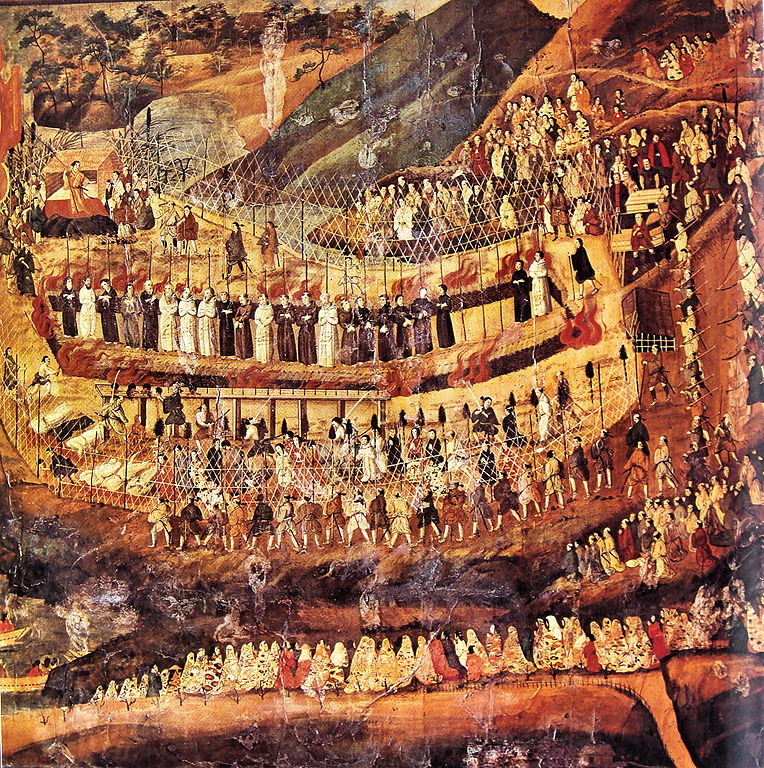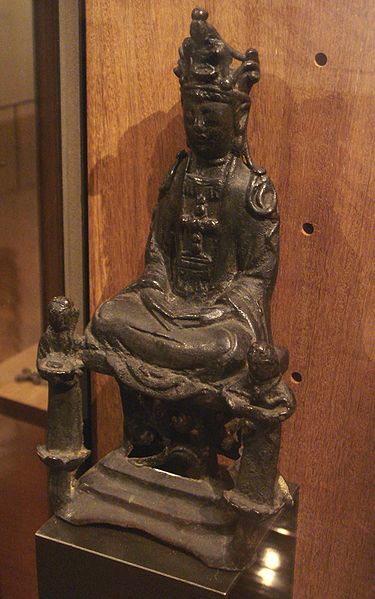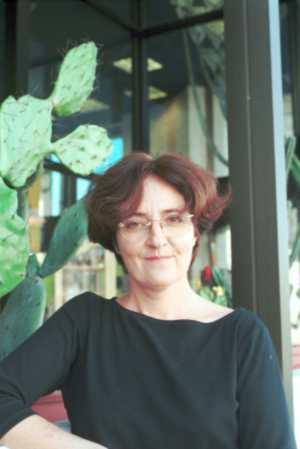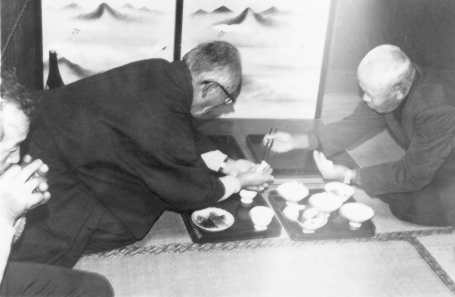RELG 402 - World's Living Religions
Christianity in Japan
Click on the Thumbnails to see larger pictures
Hover the mouse over a Thumbnail to see the caption
History
Portuguese traders had reached Japan in 1543 and set up a trading post at Kagoshima, in Kyushi. In 1549 three Jesuit missionaries arrived : Francis Xavier, Cosme de Torres and Juan Fernández. They started their mission in Kagoshima and were successful in converting large numbers of people in Kyushu, including peasants, former Buddhist monks, and members of the warrior class.
In 1559, a mission to Kyoto, the capital, was started, and by the following year there were already nine churches. The Christian community grew steadily until in 1569 there were about 30,000 Christians and 40 churches. Some of the local lords in Kyushu became Christians, there were mass baptisms of the local population, and in the 1570s the number of Christians rose rapidly to 100,000.
However, some of the Japanese feudal lords regarded the enthusiastic Japanese converts as a threat, and began to persecute them. Thousands of Japanese Christians were tortured and killed - many of them by crucifixion.
 The ruler Toyotomi Hideyoshi issued a ban on Christianity, but in spite of the ban some Franciscan missionaries also came to Kyoto. Hideyoshi reacted by formulating a more severe edict, and by executing 26 Franciscans in Nagasaki. Succeeding rulers passed more edicts prohibiting Christianity, and a great persecution began. These were the Nagasaki Martyrs of 1597.
The ruler Toyotomi Hideyoshi issued a ban on Christianity, but in spite of the ban some Franciscan missionaries also came to Kyoto. Hideyoshi reacted by formulating a more severe edict, and by executing 26 Franciscans in Nagasaki. Succeeding rulers passed more edicts prohibiting Christianity, and a great persecution began. These were the Nagasaki Martyrs of 1597.
 Many other Japanese Christians continued only in secret. They memorized what prayers and scriptures they could, and the faith was handed down from one generation to another, but without copies of the Bible or contact with other Christians. Statues of the Virgin Mary were made to look like the goddess Kanon - but with a small cross somewhere on the statue. The Japanese Hidden Christians became known as Kakure Kirishitan.
Many other Japanese Christians continued only in secret. They memorized what prayers and scriptures they could, and the faith was handed down from one generation to another, but without copies of the Bible or contact with other Christians. Statues of the Virgin Mary were made to look like the goddess Kanon - but with a small cross somewhere on the statue. The Japanese Hidden Christians became known as Kakure Kirishitan.
No foreign missionaries were allowed to enter Japan for the next 200 years.
In 1873, following the Meiji Restoration, the ban on Christianity was relaxed and freedom of religion was introduced.
As a result there was an influx of (mainly) Protestant missionaries and French Roman Catholic missionaries also arrived.
Some of the Hidden Christians emerged and rejoined the Roman Catholic Church, but others did not recognize French Catholicism as being Christian, and remained in hiding. Two centuries of isolation and hiding in fear of death had changed the Japanese Hidden Christians into a group who maintained secrecy as a part of their religion. Eventually all that remained were memories of prayers in Latin, 16th century Portuguese and Japanese, and a ritual which had lost most of its meaning.
The Hidden Christians had developed a hereditary priesthood, preserved memories of a calendar of holy days, and administered the sacrament of Baptism. For communion they used a small ball of rice rather than a communion wafer, and a cup of sake instead of wine.
 In the 1990s a cultural anthropologist, Christal Whelan, was doing research in Portugal, and became interested in the early Christians in Japan, She decided to learn Japanese and go to Japan to see if she could find out what had happened to them. For some time nothing seemed to surface - piles of old letters, but no clues about the present. Then she found a photograph - it was of a Kakure Kirishitan baptism, taken in the 1930s. Whelan reckoned that there was still a chance of finding some of the Hidden Christians. In 1991 she went to an island which at one time had been nearly 100% Hidden Christian, but when she asked about them she found that there was only one old man left, a Kakura Kirishitan priest who told her that the only other priest on the island had died ten years earlier. However, he suggested that she try another island - and there she met two very old priests, in their nineties. Whelan lived on the island for a year, participating in the ceremonies, making notes and photographs, and in 1995 she brought in a camera crew and made a film to record the ceremonies and make a documentary.
In the 1990s a cultural anthropologist, Christal Whelan, was doing research in Portugal, and became interested in the early Christians in Japan, She decided to learn Japanese and go to Japan to see if she could find out what had happened to them. For some time nothing seemed to surface - piles of old letters, but no clues about the present. Then she found a photograph - it was of a Kakure Kirishitan baptism, taken in the 1930s. Whelan reckoned that there was still a chance of finding some of the Hidden Christians. In 1991 she went to an island which at one time had been nearly 100% Hidden Christian, but when she asked about them she found that there was only one old man left, a Kakura Kirishitan priest who told her that the only other priest on the island had died ten years earlier. However, he suggested that she try another island - and there she met two very old priests, in their nineties. Whelan lived on the island for a year, participating in the ceremonies, making notes and photographs, and in 1995 she brought in a camera crew and made a film to record the ceremonies and make a documentary.
 The biggest celebration of the year was Otaiya, "The Big Evening" - Christmas Eve, when the Kakure Kirishitans should celebrate communion with three priests. However, in one case the priest had to celebrate Otaiya alone as there was no other priest in the village. In the other case the priest went to another village to join with three recent converts.
The biggest celebration of the year was Otaiya, "The Big Evening" - Christmas Eve, when the Kakure Kirishitans should celebrate communion with three priests. However, in one case the priest had to celebrate Otaiya alone as there was no other priest in the village. In the other case the priest went to another village to join with three recent converts.
They celebrated Good Friday (the Crucifixion), but Easter Sunday had lost its meaning and had become just "the time when mourning ceases" There were no Sunday services. The priests recited the Lord's Prayer, the Hail Mary, and the Salve Regina - but it seemed that they did not understand what the words meant.
After WWII and the introduction of religious freedom in 1947 Christian missionary activity has been steady.
Information on Kakure Kirishitans obtained from "Kakure Kirishitan", Patrick Downs, The Hawaii Catholic Herald, February 4, 2000
Copyright © 2015 Shirley J. Rollinson, all Rights Reserved